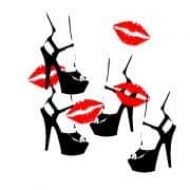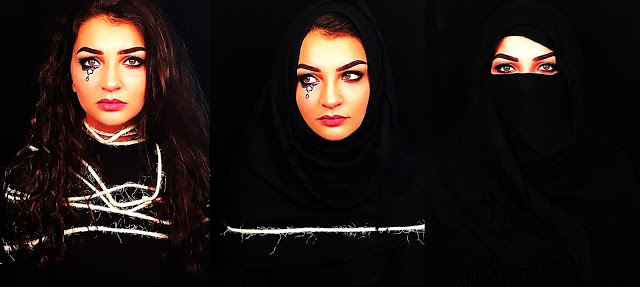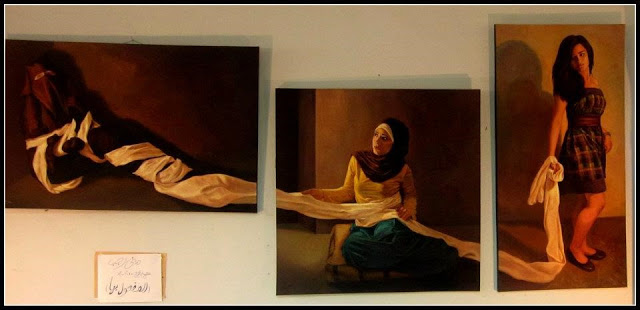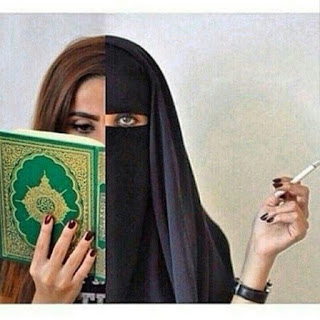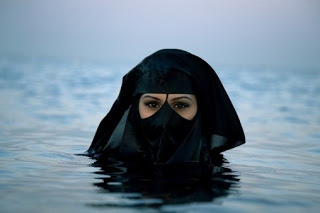I took 3 different photographs of my sister in which she resembles 3 different women. I made sure all 3 pictures are exactly the same, in terms of makeup and lighting, and focused on dark makeup on her eyes and eyebrows, for a deeper intensity. The first picture depicts my sister with her long flowy hair, dark makeup, and a black turtle neck, the second picture, I put her in traditional hijab/veil, with exactly the same setting, and the third and last picture, she was in Niqab.
My initial plan, was to paint 3 pictures of different women in the same way that are tied up with ropes, to show their distress. However, I realized, that to really express what I am trying to say, I would need to get someone in the same position I am in, and who better than my sister. So, I decided to take the pictures and paint them later on, but I faced another problem, trying to show her emotions exactly through drawing. And so finally, I decided I would use the three photograph as they are, with every detail perfectly shown, and too later sketch out and paint on the ropes, on the printed photographs.
My original influence, came from an artist I stumbled upon on Facebook, her name is Mona Ragab, and she is a university student in Egypt (fine arts). Her picture was so inspiring, and made me really think about what it’s like for women in countries like Egypt, who basically have no right at all. I complain about some of my rights here, but living in Egypt, or any of the other Middle Eastern countries, is much worse than modern Dubai. This is the original photo:
However, after much thought, especially with recent events, I was a bit annoyed, at the order of the photo. I am not veiled, so I am considered to be in the same category of the last picture on the right, but this isn’t how I view our society. Taking in consideration, that she lives in Egypt, and is veiled, I can understand what she was trying to portray. Her message, was that women in Niqab, are tied down by society, the veiled women is not as tied down, but still has major restrictions, whereas, women who are not veiled, have no restrictions whatsoever, as shown by the painting. I honestly don’t think, I would have given this painting too much thought, if I saw it 4 years ago, because it wouldn’t have dawned on me that non veiled women could be judged to a level that I have witnessed. The other picture that put most of my thoughts in perspective was this one down below.
I also stumbled upon this picture, on Facebook as well, posted along with a small Arabic poem. I have tried over, and over again, to find the reference for this picture, but sadly had no luck. I would love to meet the person behind this idea, because whoever they are, they managed to explain the story of my life, in just one picture. Looking at both the photograph, and the painting above together, changed everything for me, and allowed everything to fall in to motion. It really deconstructs a lot of stereotypes in just one photo, and moreover, shows a perfect example of “don’t judge a book by its cover”
A photographer named Sebastian Farmborough, once shot a picture of a niqabi veiled woman coming out the sea, here in Dubai. The girl was an Afghani friend of mine, and was very keen on being able to take photos like this especially because of her background. Sebastian, was born in the UK, and lived for 3 years in Saudi Arabia, and then moved to Dubai, after his short time in the Middles East, he started a theme of photos that he called “An Emerging Mystery” in which he shot niqabi veiled women in settings, they would not usually be seen in. He did this, to prove that Islam, and women in Islam, are severely understood, and he wanted to change that.
His photos, are also one of the main reason I tried to see Mona’s painting in a different way. I was mostly peeved that only niqabi veiled women are depicted as judged upon, or oppressed, or have no rights in society and media.
The statement that I tried to make, with my art project, was complicated at first, especially when I was trying to put all my ideas in one picture, but once it came together it made sense. I wanted people to understand, that yes Islam promotes, modest clothing, and a modest way of dressing but many see it through a certain lenses of veils, and covering one’s self up completely. But, that doesn’t mean, that non veiled women are bad Muslims. Yes, I am not as oppressed in society, like a woman wearing Hijab, or Niqab. Yes, I can sometimes obtain better jobs. Yes, I am allowed in more areas across the world than them. Yes, outside the Middle East, I am accepted in a way that they aren’t. And that’s where the problem starts, Egypt is my home, my country, no matter what, and the fact is, I am not accepted there as the normal deviation of a “good modern Muslim woman”.
The sad fact is, you take one look at me, and judge me on my unveiled hair, my skinny jeans, my makeup, and the fact that I do whatever I want. You take another look at veiled woman, and think one thing, “what great faith!” This obviously changed within different societies, and different places throughout the world, but for sake of argument, I am speaking from the Middle East’s point of view. I initially wanted to create ropes, on the picture of my non veiled sister only, and leave the other two pictures plain, but when I started thinking, I realized it’s not fair either. So, for this project, I will create most of the ropes on the picture without a veil, and for the other two, I will also add ropes, but not as much as the first picture. I am basically doing the opposite of Mona Ragab’s painting.
As, I am writing this, I am sitting here listening, to Um Kalthoum, and something hit me, and so I did some research. How is it that no one ever judged Um Kalthoum, on her unveiled self? I called my grandmother and asked her what it was like around the time she was growing up in the situation of Hijab, and she said: “It was very rare to see someone in Hijab, and all the women were free to wear and do whatever they want.” She also mentioned that the Sheikhs’ wives at the Azhar were not veiled, and that was seen as the norm at the time. So forget my message and my statement. I have a question, what changed? It was okay before, why did that change? And how?
When my mother got married, she wasn’t in Hijab, but shortly after she became veiled, and 18 years later took it off … This obviously was a big problem for our family back home, and for her, because people started judging her the moment they found out she used to be veiled. But what changed? Noting … she still wears the same exact clothes, and acts the same exact way, could the fact that she exposed her hair make her a terrible Muslim?
I am recently to get engaged, and as an Egyptian woman, obviously went through the normal traditions and cultures, of getting engaged. I fell in love with a man, who has been my best friend for many years, and I thought I knew everything about him, but I was wrong. I have learned, the hard way that no matter how open minded, or culturally aware a person is, their family isn’t always the same. I was wrong to make that assumption, and I didn’t try to judge them from what I have heard. The first thing, my significant other’s family asked about me was “does she wear Hijab?” I am not going to comment, and I won’t dare justify it, but can you explain to me what does that mean? The moment, I understood his family, I started thinking, “does his family even have his best interest?” if all they want is a veiled woman, then what does that say? About him? What does that say about me?
Can a veil draped across my hair really justify what kind of a person I am?
Does a veil tell you if I Pray or not?
Does a veil tell you if I mean well or not?
What does a veil say?
I suffered from traction alopecia, and what that is, is a lot of hair loss everywhere, even though I was one of the lucky ones, it affected me, in immense ways. It affected my hair, my confidence, my way of thinking, and had an impact on the person I am today. Because of alopecia, I resorted to wearing wigs, and the only thing I could think of when his mother asked him about the veil, was “welllllllll, I don’t show my hair” and I laughed, and laughed, and laughed, and that’s because , that is the only way I could have possible dealt with it. As you can tell, this description, ended with a lot of question marks, and I think that is a great symbol of how I feel at the moment, total and utter confusion.
The reason, I have held off on drawing in the ropes until now, is because drawing them on an actual photograph, can mean like they aren’t actually there, it can show that maybe I am the only one that see them there. And at this moment of time, I am not 100% sure yet.
I have always strongly believed, in the spirituality of Islam, and I might not be the symbol of a good Muslim, but that’s between me, myself, and Allah.
—————————————————————–
Sources:
—————————————————————–
THE FULL TEXT IS FOUND HERE: http://peaceartdubai.blogspot.ae/2015/12/keset-hayaty-el-gdeeda-my-new-life-story.html
